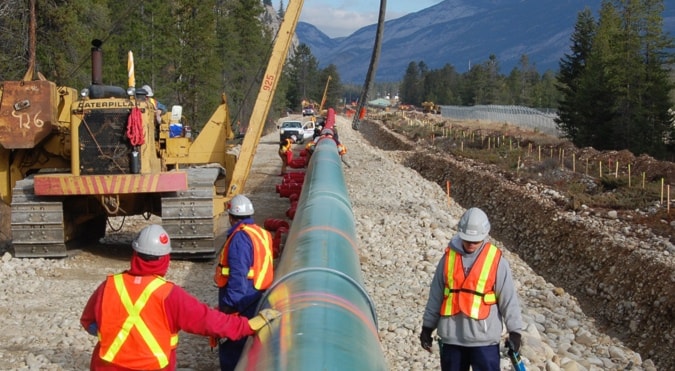Kinder Morgan has changed the preferred routing for its proposed Trans Mountain oil pipeline project in some areas and wants more time from the National Energy Board to answer more than 10,000 intervenor-submitted questions.
The company now proposes to infringe on at least three Metro Vancouver regional parks or greenways, and possibly Bridal Veil Falls Provincial Park east of Chilliwack.
In Burnaby and Coquitlam, where the project previously was to run beneath Lougheed Highway for a long stretch, it will now follow United Boulevard then cut northwest through the Brunette River Conservation Area and Brunette-Fraser Regional Greenway before reaching Burnaby Mountain.
Senior project director Greg Toth said building the pipeline under Lougheed Highway would have meant much greater disruption to traffic during construction.
He said care will be taken to minimize impacts on the greenway as well as other parks.
"We have a lot of experience operating in environmentally sensitive areas," Toth said, adding one segment of the Trans Mountain pipeline was twinned six years ago through Jasper National Park and Mt. Robson Provincial Park.
See Kinder Morgan's interactive map showing revised details of the preferred pipeline route.
The proposed $5.4-billion project would nearly triple Kinder Morgan's pipeline capacity to 890,000 barrels of oil per day and greatly increase the number of tankers passing through Vancouver harbour.
A tunnel bored through Burnaby Mountain is now the preferred route to connect a vastly expanded petroleum tank farm to the Westridge Marine Terminal for tankers on Burrard Inlet. Toth said the change dodges around Burnaby residents in the neighbourhood west of Burnaby Mountain and avoids traffic disruption to routes like Hastings Street, although that option remains a backup.
Under the new preferred routing, he said, the pipeline would not run over any private property in Burnaby.
Coquitlam environmentalists, meanwhile, are opposing the plan to use a 1.4-kilometre strip of Colony Farm Regional Park as a pipe assembly work zone.
A section of pipeline would be built there and then pulled into a tunnel to be drilled under the Fraser River to Surrey next to the Port Mann Bridge.
The parkland would be restored to its previous condition, Toth said, but added alternatives to using Colony Farm continue to be explored.
In Surrey, the pipeline would run along the South Fraser Peritmeter Road and along the southwest flank of Surrey Bend Regional Park to Golden Ears Way near 96 Avenue. Toth said route changes there have reduced the section within Surrey Bend by about one kilometre.
In north Langley, the route now runs through or adjacent to The Redwoods Golf Course, instead of the through the Salmon River valley further east near Fort Langley.
East of Chilliwack, a section that was previously to run on the north side of Highway 1 is now proposed to follow the original pipeline corridor through the northwest corner of Bridal Veil Falls Provincial Park. The switch avoids using a new route near Cheam Lake Wetlands Regional Park on the other side of the freeway that locals opposed.
Toth said a wider corridor there could allow the new pipeline to bypass the provincial park by using local roads.
The Trans Mountain Pipeline was built in 1952 and pre-dates many B.C. parks, including Bridal Veil, that have since been created.
Besides Bridal Veil, the twinned corridor would run through North Thompson Provincial Park, Fin Creek Provincial Park, as well as the Lac Dubois and Coquihalla Summit protected areas.
Toth said routing currently proposed would bypass five other provincial parks that the current pipeline runs through.
Specific concerns in the Fraser Valley include the risk of an oil spill contaminating the aquifer that provides Chilliwack's drinking water.
Toth said that's one of the "high-consequence areas" where Kinder Morgan will explore options to better protect the pipeline – potentially by making it thicker, burying it deeper and placing more frequent shut-off valves to minimize any spill.
Meanwhile, Kinder Morgan staff are scrambling to answer a blizzard of questions filed by intervenors, including 1,500 from the City of Burnaby alone.
Kinder Morgan vice-president Scott Stoness said he's hopeful the requested delay of the deadline for answers from June 4 to June 27 – if approved by the NEB – won't push back later deadlines in the pipeline review process.
Intervenors would still have about two months to study the company's responses before their next deadline for the second set of information requests in September.
"Our team has been working around the clock to answer every question within the scope of the NEB review thoughtfully and with care," Stoness said, but said they can't all be answered by the original deadline.

Map showing new revised routing in green through or near Bridal Veil Falls Provincial Park.
